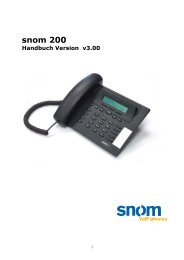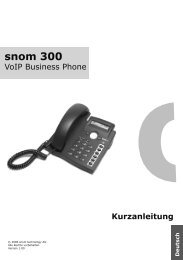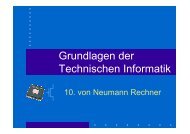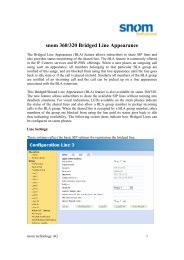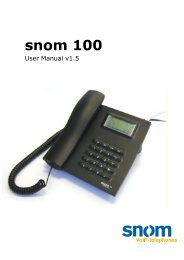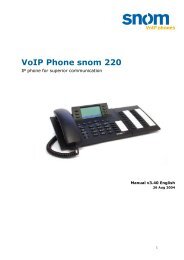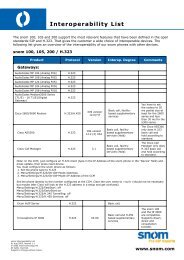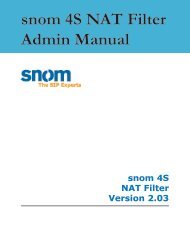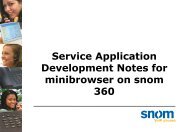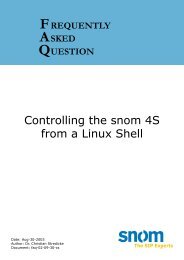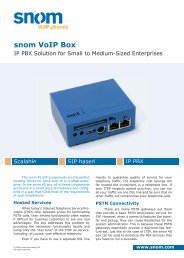You also want an ePaper? Increase the reach of your titles
YUMPU automatically turns print PDFs into web optimized ePapers that Google loves.
F REQUENTLY<br />
A SKED<br />
Q UESTION<br />
<str<strong>on</strong>g>Using</str<strong>on</strong>g> <str<strong>on</strong>g>the</str<strong>on</strong>g> <str<strong>on</strong>g>Dial</str<strong>on</strong>g> <str<strong>on</strong>g>Plan</str<strong>on</strong>g> <strong>on</strong> <str<strong>on</strong>g>the</str<strong>on</strong>g><br />
Date: Mar-27-2004<br />
Author: Christian Stredicke<br />
Document: faq-04-03-27-cs<br />
<strong>snom</strong> ph<strong>on</strong>es
On <str<strong>on</strong>g>the</str<strong>on</strong>g> ph<strong>on</strong>e, a dial plan may have <str<strong>on</strong>g>the</str<strong>on</strong>g><br />
following functi<strong>on</strong>s:<br />
• Determine when a number is complete<br />
(e.g. ten-digit number in USA)<br />
• Automatically c<strong>on</strong>vert local numbers into<br />
global numbers (e.g. dialing 398330<br />
in Berlin, Germany gets c<strong>on</strong>verted into<br />
+4930398330)<br />
• Automatically append <str<strong>on</strong>g>the</str<strong>on</strong>g> local domain<br />
(e.g. dialing 398330 gets c<strong>on</strong>verted into<br />
sip:398330@company.com;user=ph<strong>on</strong>e)<br />
The ph<strong>on</strong>e is able to generate predefined<br />
dial plans from <str<strong>on</strong>g>the</str<strong>on</strong>g> user interface (see <str<strong>on</strong>g>the</str<strong>on</strong>g><br />
descripti<strong>on</strong> of <str<strong>on</strong>g>the</str<strong>on</strong>g> ph<strong>on</strong>e user interface).<br />
The dial plan depends <strong>on</strong> <str<strong>on</strong>g>the</str<strong>on</strong>g> outgoing<br />
line identity; <str<strong>on</strong>g>the</str<strong>on</strong>g>refore <str<strong>on</strong>g>the</str<strong>on</strong>g> <strong>snom</strong> ph<strong>on</strong>e<br />
supports seven dial plan entries. Those entries<br />
are available in <str<strong>on</strong>g>the</str<strong>on</strong>g> SIP/Stack settings.<br />
From a requirement point of view, dial<br />
plans are similar to <str<strong>on</strong>g>the</str<strong>on</strong>g> replacements known<br />
from ENUM or NAPTR. Therefore, <strong>snom</strong> built<br />
up<strong>on</strong> <str<strong>on</strong>g>the</str<strong>on</strong>g>se mechanisms and added some<br />
more features that make <str<strong>on</strong>g>the</str<strong>on</strong>g>m suitable for <str<strong>on</strong>g>the</str<strong>on</strong>g><br />
above scenarios.<br />
The first additi<strong>on</strong>al feature is that <str<strong>on</strong>g>the</str<strong>on</strong>g>re<br />
can be more than <strong>on</strong>e pattern. The patterns<br />
are separated by spaces. The first pattern<br />
which yields a match is taken.<br />
<str<strong>on</strong>g>Dial</str<strong>on</strong>g> <str<strong>on</strong>g>Plan</str<strong>on</strong>g> Entries<br />
<str<strong>on</strong>g>Dial</str<strong>on</strong>g> plan entries have three parts. The<br />
parts may be seperated by any character;<br />
typically <str<strong>on</strong>g>the</str<strong>on</strong>g> characters “!” or “|” are used for<br />
seperati<strong>on</strong>.<br />
The first part c<strong>on</strong>tains a pattern which<br />
is used for matching <str<strong>on</strong>g>the</str<strong>on</strong>g> dialled number. The<br />
sec<strong>on</strong>d part c<strong>on</strong>tains <str<strong>on</strong>g>the</str<strong>on</strong>g> result or <str<strong>on</strong>g>the</str<strong>on</strong>g> dial plan<br />
step and <str<strong>on</strong>g>the</str<strong>on</strong>g> third (opti<strong>on</strong>al) part c<strong>on</strong>tains<br />
flags that set additi<strong>on</strong>al processing attributes.<br />
The following flags are available:<br />
• The “d” flag means that <str<strong>on</strong>g>the</str<strong>on</strong>g> number is<br />
complete and can be dialed. Example:<br />
“|[0-9]{5}|sip:\1@test.com|d” means<br />
that a number with five digits will be dialed<br />
automatically.<br />
• The “i” flag means that <str<strong>on</strong>g>the</str<strong>on</strong>g> comparis<strong>on</strong>s<br />
should be d<strong>on</strong>e case-insensitive.<br />
[ F R E Q U E N T L Y A S K E D Q U E S T I O N ]<br />
Substituti<strong>on</strong>s<br />
Substituti<strong>on</strong>s are found in <str<strong>on</strong>g>the</str<strong>on</strong>g> sec<strong>on</strong>d<br />
part of <str<strong>on</strong>g>the</str<strong>on</strong>g> dial plan entry. The following<br />
substituti<strong>on</strong>s are available:<br />
• The “d” replacement inserts <str<strong>on</strong>g>the</str<strong>on</strong>g> name of<br />
<str<strong>on</strong>g>the</str<strong>on</strong>g> registrar. For example, „!*!sip:\1@\d!“<br />
inserts <str<strong>on</strong>g>the</str<strong>on</strong>g> domain name behind <str<strong>on</strong>g>the</str<strong>on</strong>g> „@“<br />
symbol.<br />
• The 1-9 replacements insert matches 1-<br />
9 according to RFC2915. For example,<br />
“!(.+)!sip:\1!” inserts a “sip:” before <str<strong>on</strong>g>the</str<strong>on</strong>g><br />
string (which is <str<strong>on</strong>g>the</str<strong>on</strong>g> first match).<br />
Triggering ENUM<br />
The ph<strong>on</strong>e supports ENUM lookup. In<br />
order to trigger <str<strong>on</strong>g>the</str<strong>on</strong>g> steps described in <str<strong>on</strong>g>the</str<strong>on</strong>g><br />
ENUM RFC2916, <str<strong>on</strong>g>the</str<strong>on</strong>g> SIP URI must c<strong>on</strong>tain <str<strong>on</strong>g>the</str<strong>on</strong>g><br />
parameter ph<strong>on</strong>e set to yes (“;ph<strong>on</strong>e=yes”).<br />
The ENUM handling of <str<strong>on</strong>g>the</str<strong>on</strong>g> ph<strong>on</strong>e is described<br />
in a separate document.<br />
Summary of extended regular<br />
expressi<strong>on</strong>s<br />
See also <str<strong>on</strong>g>the</str<strong>on</strong>g> Internet for detail descripti<strong>on</strong><br />
of extended regular expressi<strong>on</strong>s.<br />
• To match a character, just use that character.<br />
If a character has a special meaning, it has<br />
to be escaped by <str<strong>on</strong>g>the</str<strong>on</strong>g> backslash character.<br />
• ^ matches <str<strong>on</strong>g>the</str<strong>on</strong>g> beginning of a string, $<br />
matches <str<strong>on</strong>g>the</str<strong>on</strong>g> end of a string<br />
• dot („.“) matches every character.<br />
• To match a range of characters, use [<br />
and ] and list <str<strong>on</strong>g>the</str<strong>on</strong>g> characters between <str<strong>on</strong>g>the</str<strong>on</strong>g><br />
brackets. Ranges can be defined by <str<strong>on</strong>g>the</str<strong>on</strong>g><br />
dash symbol. Ranges can be negated by<br />
<str<strong>on</strong>g>the</str<strong>on</strong>g> ^ symbol (for example [^0-9] matches<br />
all characters but numbers).<br />
• „+“, „*“, „?“ are multipliers which match<br />
at least <strong>on</strong>ce („+“), a unlimited number<br />
of times („*“) and at most <strong>on</strong>ce („?“).<br />
Multipliers can also be explicitly stated in<br />
curly brackets, for example {5,9} means at<br />
least 5 times, at most 9 times. {5,} means<br />
at least five times, {5} means exactly<br />
five times. Without multiplier, exactly <strong>on</strong>e<br />
match is expected.<br />
• Brackets can be used to group matches<br />
(like in „(abc)?“ which matches „abc“ or<br />
<str<strong>on</strong>g>the</str<strong>on</strong>g> empty string).<br />
• The „|“ can be used to indicate alternate<br />
matches (like in „a|b“ which matches a or<br />
2 <strong>snom</strong> technology AG
).<br />
Examples:<br />
• “(sip:)?(+?[0-9]+)@.+” matches SIP<br />
URI that c<strong>on</strong>tain a teleph<strong>on</strong>e number<br />
(like sip:+4930432343@isp.de or<br />
30432343@isp.de).<br />
• “^sip:([^@]*)@(.*)” matches SIP URI that<br />
c<strong>on</strong>tain a user name<br />
• “http://([^/:]+)” matches typical http URL<br />
(like “http://bla.test.com/test.htm”)<br />
• “(A(B(C)DE)(F)G)” matches “ABCDEFG”<br />
• “(http://([^/:]+))|(SIP:([^@]+)@.*)”<br />
matches a http URL or a SIP URI.<br />
• “urn:cid:.+@([^\\.]+\\.)(.*)$” matches<br />
for example “urn:cid:39CB83F7.A8450130<br />
@fake.gatech.edu”.<br />
Examples for <str<strong>on</strong>g>Dial</str<strong>on</strong>g> <str<strong>on</strong>g>Plan</str<strong>on</strong>g>s<br />
One comm<strong>on</strong> usage is to c<strong>on</strong>vert an<br />
emergency number into a SIP URL. This<br />
pattern could look like this: “!^911$!sip:<br />
emergency@local!d”. Separated by <str<strong>on</strong>g>the</str<strong>on</strong>g><br />
exclamati<strong>on</strong> mark, it c<strong>on</strong>tains <str<strong>on</strong>g>the</str<strong>on</strong>g> pattern for<br />
<str<strong>on</strong>g>the</str<strong>on</strong>g> 911 and <str<strong>on</strong>g>the</str<strong>on</strong>g> resulting SIP URI. The d flag<br />
indicates that <str<strong>on</strong>g>the</str<strong>on</strong>g>re is no need to press <str<strong>on</strong>g>the</str<strong>on</strong>g> Ok<br />
key after dialing this number.<br />
Ano<str<strong>on</strong>g>the</str<strong>on</strong>g>r comm<strong>on</strong> problem is to make<br />
<str<strong>on</strong>g>the</str<strong>on</strong>g> ph<strong>on</strong>e dial a number when <str<strong>on</strong>g>the</str<strong>on</strong>g> pound<br />
key is pressed. The pattern could look like<br />
this: “!([^#]+)#!sip:\1@\d!d”. This dial plan<br />
entry will look for a pattern ending in a pound<br />
symbol and use this as <str<strong>on</strong>g>the</str<strong>on</strong>g> user name in a SIP<br />
URI (not including <str<strong>on</strong>g>the</str<strong>on</strong>g> pound symbol).<br />
Matching an internati<strong>on</strong>al number is<br />
easy. Just put <str<strong>on</strong>g>the</str<strong>on</strong>g> 011 pattern at <str<strong>on</strong>g>the</str<strong>on</strong>g> fr<strong>on</strong>t<br />
of <str<strong>on</strong>g>the</str<strong>on</strong>g> pattern, like in “|^011([0-9]*)$|sip:<br />
+\1@\d;ph<strong>on</strong>e=yes|”. This pattern requires<br />
that <str<strong>on</strong>g>the</str<strong>on</strong>g> user presses <str<strong>on</strong>g>the</str<strong>on</strong>g> Ok key in order to<br />
start <str<strong>on</strong>g>the</str<strong>on</strong>g> call.<br />
To make <str<strong>on</strong>g>the</str<strong>on</strong>g> ph<strong>on</strong>e dial a number<br />
when a certain number of digits have been<br />
reached, <str<strong>on</strong>g>the</str<strong>on</strong>g> following dial plan entry could<br />
be used: “|^1([0-9]{10})$|sip:+1\1@\<br />
d;ph<strong>on</strong>e=yes|d”. This pattern will look for a<br />
number starting with 1 and followed by ten<br />
digits. It will replace it with a URI that c<strong>on</strong>tain<br />
<str<strong>on</strong>g>the</str<strong>on</strong>g> hint to try an ENUM lookup first before<br />
sending it to <str<strong>on</strong>g>the</str<strong>on</strong>g> proxy.<br />
Calling a complete URI is a little bit<br />
more difficult because of <str<strong>on</strong>g>the</str<strong>on</strong>g> number of<br />
allowed characters in <str<strong>on</strong>g>the</str<strong>on</strong>g> user name. The<br />
following character can be base for such a<br />
[ F R E Q U E N T L Y A S K E D Q U E S T I O N ]<br />
dial plan entry: “|^([a-zA-Z0-9&=+\$,;?\-_<br />
.!~*‘()%]+@.+)|sip:\1|”. It is not necessarily<br />
<str<strong>on</strong>g>the</str<strong>on</strong>g> last word in this topic, as <str<strong>on</strong>g>the</str<strong>on</strong>g> user name<br />
part of <str<strong>on</strong>g>the</str<strong>on</strong>g> URI also may c<strong>on</strong>tain passwords.<br />
<str<strong>on</strong>g>Dial</str<strong>on</strong>g> <str<strong>on</strong>g>Plan</str<strong>on</strong>g> <strong>on</strong> <strong>snom</strong> ph<strong>on</strong>e 3
<strong>snom</strong> technology Aktiengesellschaft<br />
Pascalstr. 10B, 10587 Berlin, Germany<br />
Ph<strong>on</strong>e: +49 (30) 39833-0<br />
mailto: info@<strong>snom</strong>.com<br />
http: www.<strong>snom</strong>.com<br />
sip: info@<strong>snom</strong>.com<br />
© 2004 <strong>snom</strong> technology AG<br />
All rights reserved.




